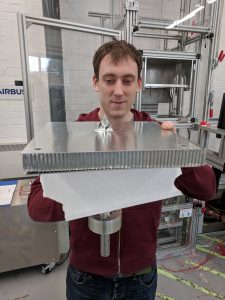STEVENAGE, England (Reuters) – A European satellite launched this week to try out ways of tackling the growing amount of garbage in space will use technology as familiar to the ancient Romans as astronauts – nets and harpoons.
Engineers who have designed and created harpoons for two pioneering space debris clearing projects said the appeal of such time-tested concepts was their simplicity.
“The irony is not lost on us,” said Alastair Wayman, an advanced projects engineer at Airbus Space in the southern English town of Stevenage.

Alastair Wayman, Advanced Projects Engineer at Airbus Space, examines the tip of a large harpoon after a test firing into a simulated section of satellite as part of an European Space Agency project in Stevenage, Britain, April 4, 2018. Picture taken April 4, 2018. REUTERS/Stuart McDill
“This is a really nice, simple piece of technology but what we’ve done is we’ve updated it for use in space and the beauty of this system is in its simplicity,” he told Reuters.
The RemoveDebris satellite is carrying a number of different devices designed to help clear the huge amount of debris orbiting the earth. It has already docked with the International Space Station and the tests are expected to begin in the next few weeks.
“All we have to do is sit away from our target spacecraft, fire our harpoon towards it and then once it’s impacted we’ve captured our piece of space debris,” said Wayman.
One of the harpoons is around 30 cm (one foot) long, and is designed to fire at a target on an arm around 20 meters (65 ft) away, before reeling it back in on a rope.
A larger harpoon, around 1.5 metres-long and weighing 2.2 kg (5 lb) is also being designed in the lab, as part of the European Space Agency’s Clean Space program. It aims to capture space junk targets weighing up to eight tonnes (17,000 lb).
Scientists estimate as much as 7,000 tonnes of junk is orbiting the earth at speeds of up to 27,000 km/h (17,000 mph) and it is capable of damaging satellites or spacecraft.
The debris ranges from tiny items such as screws or chips of paint to rocket sections or defunct satellites.
Other devices being tested on the RemoveDebris satellite include a net to catch debris, a light-based ranging system known as LIDAR, and a sail that will pull the craft back into earth’s atmosphere where it and the debris would burn up harmlessly.
(Reporting by Stuart McDill; Writing by Mark Hanrahan in London; editing by David Stamp)
 A small harpoon system, identical to the one in space now on the RemoveDebris satellite, is seen at the European Space Agency project in Stevenage, Britain, April 4, 2018. Picture taken April 4, 2018. REUTERS/Stuart McDill
A small harpoon system, identical to the one in space now on the RemoveDebris satellite, is seen at the European Space Agency project in Stevenage, Britain, April 4, 2018. Picture taken April 4, 2018. REUTERS/Stuart McDill
